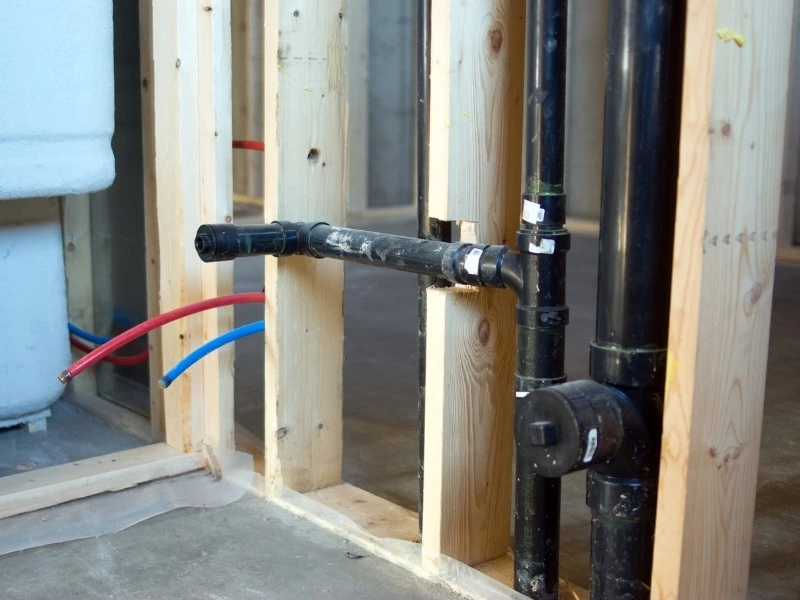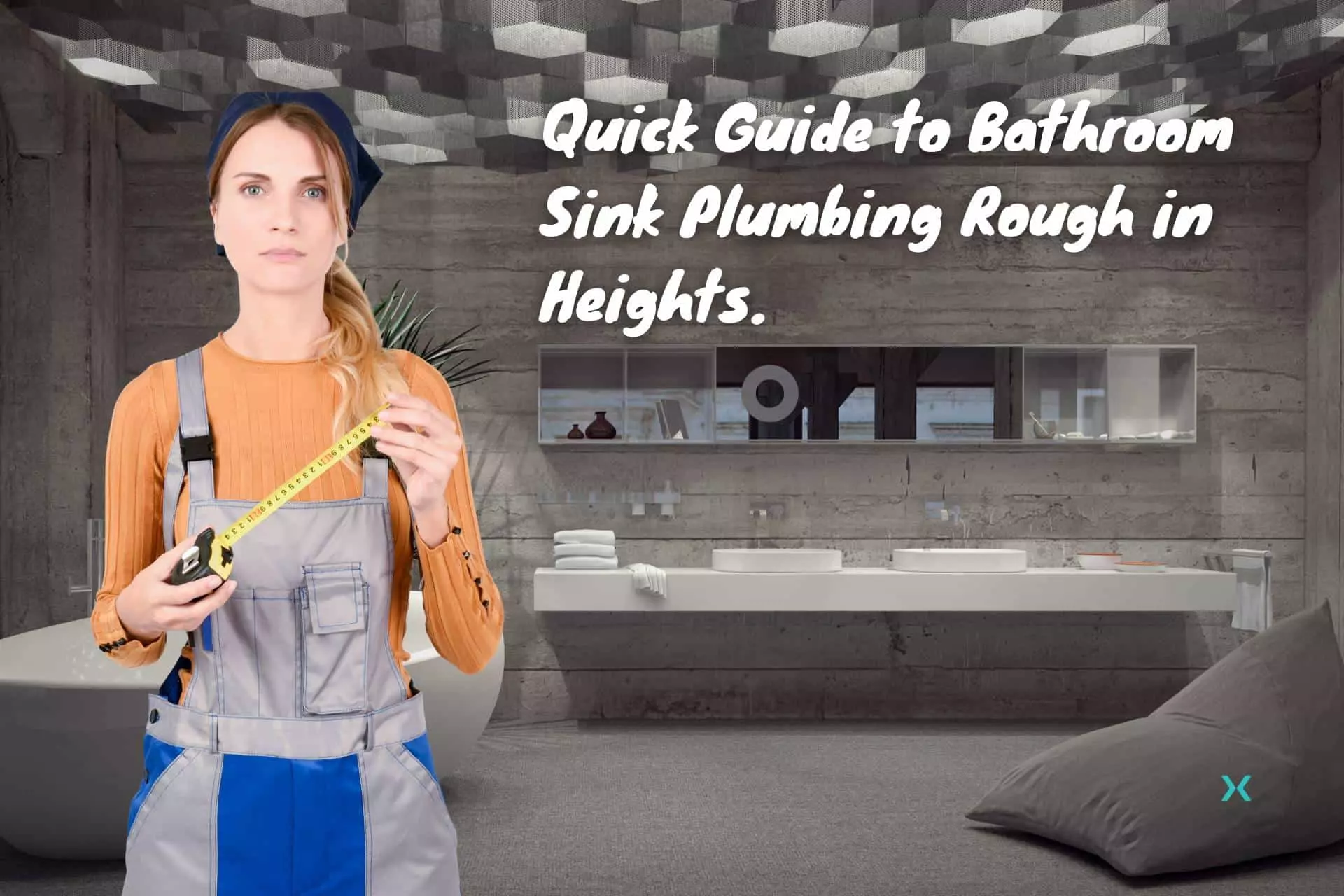Quick Guide to Bathroom Sink Plumbing Rough in Heights.
Hello, homeowners! Have you ever wondered about the bathroom sink plumbing rough in heights? It may sound complex, but we’re here to simplify it for you.
‘Rough in height’ is a plumbing term referring to the distance from the floor to where the pipes enter your sink – an essential element for a well-functioning sink.
This guide will shed light on everything you need to know about it. By understanding these intricacies, not only do you become self-reliant and make the installation process easier, but you also save on professional fees.
So, ready your tape measure, don your DIY hat, and join us as we delve into the world of bathroom sink plumbing!
Table of Contents
💧 What Does a Bathroom Rough-In Include?

A bathroom rough-in includes the initial stage of a plumbing installation where the pipes and hardware are positioned, but the supply and drain lines are not yet connected.
It’s like the skeleton of your bathroom plumbing!
Here’s what it typically involves:
- Drain Pipes: These are positioned to carry water away from sinks, bathtubs, showers, and toilets.
- Vent Stacks: These prevent sewer gases from entering your home and help maintain proper pressure for drain flow.
- Water Supply Lines: These lines bring fresh water to your bathroom fixtures.
- Fixture Placement: The locations for sinks, toilets, showers, and bathtubs are marked out.
Remember, understanding your bathroom rough-in is crucial in mastering home maintenance.
💧 Understanding Rough-In Dimension Terminology

Understanding these terms is like having a blueprint for your project — it helps you confidently navigate the process.
- Rough-In: This is the stage in construction when mechanical, electrical, and plumbing lines are installed but not yet connected. It’s like laying the groundwork for a garden before planting the flowers.
- Drain Pipes: These pipes installed during the rough-in stage carry water away from fixtures like bathroom sinks, bathtubs, and toilets into the drain outlet. Imagine them as the channels directing rainwater away from your home.
- Vent Stacks: These are installed during the rough-in phase to prevent sewer gases from entering your home and maintain proper drain flow pressure. They’re like the chimney for your plumbing system.
- Water Supply Lines: These lines installed during the rough-in phase bring fresh water to bathroom fixtures. Think of them as the water supply for your home’s thirstiest features.
- Centerline: Frequently used in plumbing, this term refers to the central point of a fixture or pipe. It’s like the bullseye on a dartboard, helping you aim accurately.
- Rough-In Size: The standard rough-in size for toilets is the distance between the bare wall and the center of the toilet drainpipe, also known as the toilet flange. It’s like measuring the space for a new piece of furniture in your living room.
- Vertical Rough-In: This refers to the distance from the finished floor to the center of the sink drain. It’s like knowing the height of a ladder you need to reach a certain point.
- Base Floor Height: This is the vertical distance from the ground level to the surface of your floor. It’s like knowing the first step’s height on a staircase.
💧 Factors to Consider When Choosing a Bathroom Sink Height

When choosing a bathroom sink height, it’s essential to consider standard height recommendations.
In most bathroom sinks, the ideal range falls between 32 to 36 inches from the floor to the top of the sink countertop.
However, these measurements can be adjusted based on individual preferences and user needs.
Also, the following tips will help you to be successful with your project.
- Thorough Planning: Before diving into any plumbing work, meticulously plan the layout. Ensure that the placement of fixtures, pipes, and drains aligns with your bathroom design.
- Accurate Measurements: Precision is key. Use precise measuring tools to determine the exact placement of plumbing fixtures. This prevents issues down the road and saves both time and money. Measure twice, cut once!
- Adhere to Codes: Familiarize yourself with local plumbing codes and regulations. Ensure you access updated information to stay in compliance.
- Quality Materials: Invest in high-quality plumbing materials and fixtures. This ensures durability and minimizes the risk of leaks or other plumbing issues.
- Professional Consultation: If you’re uncertain about any plumbing rough-in aspect, consult a professional plumber. Their expertise can be invaluable.
- Future-Proofing: Consider potential future needs when planning your rough-in. Leave some room for expansion or upgrades to accommodate changing preferences or family size.
📗 Resources: 2021 International Plumbing Code (IPC)
💧 What Are the Full Dimensions for Bathroom Sink Rough-in Plumbing?

Precise measurements are paramount to ensure a seamless installation when planning a bathroom sink rough-in plumbing project.
Here are the standard dimensions you’ll need:
The rough-in height typically ranges from 30 to 32 inches from the finished floor to the centerline of the drain.
This measurement ensures proper drainage and that all the plumbing components function correctly.
To ensure proper installation and ease of use, allow for a minimum of 15 inches of clearance from the centerline of the sink to any side wall or obstacle. This prevents crowding and allows for faucet and handle operation.
Adhering to these dimensions for bathroom sink rough-in plumbing ensures that your installation is both functional and visually appealing.
There’s a chance that your bathroom vanity requires modifications for plumbing routings.
Especially the vanity structures against the wall might need to be cut or reconfigured to accommodate the rough in configuration.
🔧 The Supply Line
Hot and cold water supply lines should be located about 4 inches apart on either side of the sink’s centerline, with the faucet holes corresponding to these positions.
The typical height for water supply pipes in a bathroom sink installation is about 8 to 10 inches above the finished floor.
This height ensures the sink supply lines are accessible and connect comfortably to the faucet’s valves or handles.
However, it’s essential to consider the specific sink and faucet model you’re installing, as the recommended supply line height can vary slightly based on the design and manufacturer’s instructions.
Always follow the guidelines provided with your sink and faucet for the most accurate installation.
🔧 P-Trap Placement
The P-trap should be positioned approximately 6 to 8 inches below the bathroom sink drain.
This keeps the water sealed and prevents sewer gases from entering your bathroom.
The tailpiece, which connects the sink drain to the P-trap, typically measures around 4 to 6 inches.
Ensure it aligns with the sink’s drain opening for a secure connection.
📗 Related Reading: What Is a P Trap and How Does It Work?
🔧 Fixture (Side-to-Side Buffer)
A side-to-side buffer is essential to ensure the sink fixture can be operated comfortably and effectively without obstructions.
The specific measurement of the side-to-side buffer can vary based on the sink and fixture design, but a general guideline is to provide at least 4 to 6 inches of clearance on each side of the fixture.
This space allows for ease of use, prevents interference with adjacent objects, and ensures that the faucet handles or controls can be operated without obstruction.
🔧Fixture (Front Buffer)
In bathroom sink plumbing, the “front buffer” or “fixture buffer” refers to the space or clearance between the front edge of the sink and any obstacles or objects in front of it.
The fixture front buffer can vary depending on the sink’s design and the user’s preferences. However, a general guideline is to provide at least 4 to 6 inches of clearance in front of the sink.
This space allows easy access to the sink, making tasks like handwashing more convenient.
It also prevents objects, such as a cabinet or wall, from obstructing the user’s ability to use the sink effectively.
💧 Frequently Asked Questions
What Are the Dimensions for Rough-in Plumbing for Vanity Cabinets?
The rough-in plumbing dimensions for vanity cabinets typically include:
Width: Standard widths range from 18 to 72 inches or more.
Depth: Standard depths are around 21 inches, excluding countertop overhang.
Height: Standard heights range from 31 to 36 inches.
These dimensions can vary based on cabinet design and user preferences.
What Are the Rough In Dimensions for Toilets?
The rough-in dimensions for toilets refer to the distance between the finished wall and the center of the toilet’s drainpipe outlet.
The most common rough-in dimension is 12 inches, the standard in many residential bathrooms.
However, other rough-in sizes, including 10 and 14 inches, are sometimes used.
Measuring the rough-in dimension accurately when installing or replacing a toilet is crucial to ensure a proper fit.
What Are the Rough-In Dimensions for a Shower?
Shower Width: The width of a shower stall can vary but is typically at least 32 inches for a comfortable showering experience.
Shower Depth: A standard depth for a shower is around 30 inches, which provides sufficient space for showering comfortably.
Shower Height: The showerhead is typically installed at a height of 78 inches from the shower floor. This height can be adjusted based on user preferences.
Drain Location: The shower drain is usually centered within the shower stall.
What are the Rough In Dimensions for a Bathtub?
Bathtub Length: Standard bathtub lengths range from 60 to 72 inches. The length can vary based on the type of bathtub, such as a standard alcove or a freestanding tub.
Bathtub Width: The width of a standard bathtub is typically around 30 to 32 inches.
Bathtub Height: The height of the bathtub rim can vary, but it’s usually around 14 to 19 inches from the bathroom floor.
Drain Location: The bathtub drain is typically centered along the tub’s length.
These dimensions provide a general guideline, but it’s important to consult the manufacturer’s specifications and follow local building codes when installing or roughing in shower and bathtub fixtures, as variations can occur based on design choices and regional requirements.
💧 Conclusion

In this comprehensive guide, we’ve decoded the intricate world of bathroom sink plumbing rough-in heights, and much more.
By understanding the fundamentals of rough-in dimensions, you empower yourself to tackle plumbing projects, potentially saving on professional fees while ensuring precise installations.
We’ve covered everything from the basics of rough-in plumbing to the terminology you need to know.
Remember, precision, adherence to codes, quality materials, and future-proofing are your allies in achieving a successful plumbing rough-in.
So, equip yourself with this knowledge, grab your tools, and confidently embark on your bathroom plumbing journey.
Your home maintenance prowess just leveled up!
Want to learn more about your home’s plumbing system? Feel free to check out our other plumbing articles.
📗 Related Reading: DIY Guide to 15 Common Plumbing Problems & Solutions

